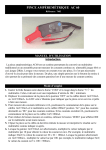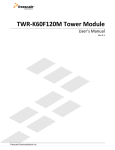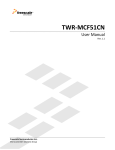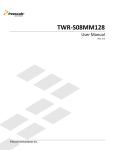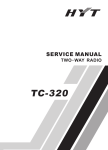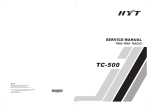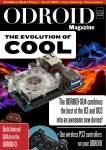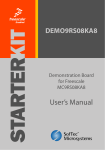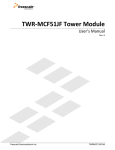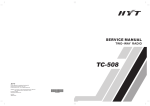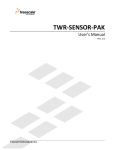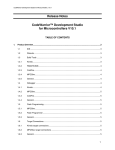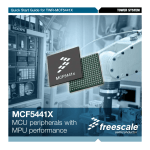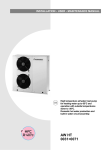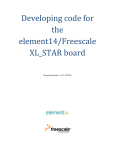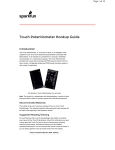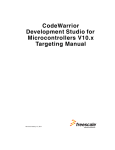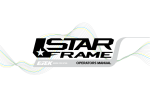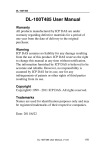Download TWR-S08UNIV - Freescale Semiconductor
Transcript
TWR-S08UNIV User's Manual Rev. 1 Freescale Semiconductor Inc. TWRS08UNIVUM Table of Contents 1. TWR-S08UNIV and TWR-S08DC Overview .....................................................................................4 1.1 Contents .................................................................................................................................................................................. 5 1.2 Features .................................................................................................................................................................................. 5 2. Getting Started..........................................................................................................................................7 2.1 Reference Documents ....................................................................................................................................................... 7 3. Hardware Description ...........................................................................................................................7 3.1 Daughter Cards TWR-S08DC-XXX for the TWR-S08UNIV Module................................................................. 8 3.2 System Power ....................................................................................................................................................................... 9 3.2.1 TWR-S08DC-XXX Daughter Cards 3V/5V Switch ................................................................................................................ 9 3.3 Debug Interface ................................................................................................................................................................... 9 3.3.1 OSBDM .................................................................................................................................................................................................... 9 3.3.2 BDM Multilink 6-PIN ...................................................................................................................................................................... 10 3.4 Potentiometer, Pushbuttons, LEDs, Beeper .......................................................................................................... 10 3.5 General Purpose Tower Plug-in (TWRPI) Socket............................................................................................... 10 3.6 Touch Pad Tower Plug-in (TWRPI) Socket ........................................................................................................... 11 3.7 Touch Sensor Tower Plug-in (TWRPI) TWRPI .................................................................................................... 11 4. Software - CodeCreator ...................................................................................................................... 12 5. DIP Switch Table ................................................................................................................................... 13 6. Input/Output Connections for Daughter Cards ......................................................................... 14 7. Tower Elevator Connections ............................................................................................................ 14 TWRS08UNIVUM TWR-S08UNIV User's Manual Page 2 of 16 List of Figures Figure 1. Freescale Tower System Overview .............................................................................................. 4 Figure 2. Callouts on the TWR-S08UNIV ..................................................................................................... 6 Figure 3. Callouts on TWR-S08UNIV Daughter Cards ................................................................................. 6 Figure 4. TWR-S08UNIV Block Diagram ...................................................................................................... 8 List of Tables Table 1. BDM Multilink 6-PIN Connector Pinout ...................................................................................... 10 Table 2. General Purpose TWRPI socket pinout ....................................................................................... 10 Table 3. Touch Pad TWRPI socket pinout ................................................................................................. 11 Table 4. Touch Sensor TWRPI socket pinout ............................................................................................ 12 Table 5. TWR-S08UNIV DIP Switch Table .................................................................................................. 13 Table 6. TWR-S08UNIV Primary Connector Pinout................................................................................... 14 Revision History TWRS08UNIVUM Revision 0 Date Sept 1,2011 1 January 5, 2012 Changes Initial Release Fixed typos in part numbers for the TWRUNIV and TWR-UNIV-DEMO TWR-S08UNIV User's Manual Page 3 of 16 1. TWR-S08UNIV and TWR-S08DC Overview The TWR-S08UNIV is a Tower Controller Module compatible with the Freescale Tower System. It can function as a stand-alone, low-cost platform for the evaluation of the many of our S08/RS08 microcontrollers in conjunction with the TWR-S08DC daughter cards. The TWR-S08UNIV is available as a stand-alone product or as a kit (TWR-S08UNIV-DEMO) that includes all six original (R)S08 daughter cards. The TWR-S08UNIV can also be combined with other Freescale Tower peripheral modules to create development platforms for a wide variety of applications. Figure 1 provides an overview of the Freescale Tower System. Figure 1. Freescale Tower System Overview TWRS08UNIVUM TWR-S08UNIV User's Manual Page 4 of 16 1.1 Contents The TWR-S08UNIV contents include: TWR-S08UNIV board assembly 3ft USB cable Interactive DVD with software installers and documentation Quick Start Guide The TWR-S08UNIV-DEMO contains: TWR-RS08DC-KA8 TWR-S08DC-AC60 TWR-S08DC-QD4 TWR-S08DC-QE64 TWR-S08DC-QG8 TWR-S08DC-SH8 1.2 Features Figure 2 and Figure 3 show the TWR-S08UNIV with some of the key features called out. The following list summarizes the features of the TWR-S08UNIV Tower Module: Tower compatible universal board module Interchangeable Daughter Card Sockets for many S08/RS08 microcontrollers Touch Tower Plug-in Socket Touch Sense Tower Plug-in (TWRPI) socket General purpose Tower Plug-in (TWRPI) socket On-board OSBDM debug circuit (OSBDM) with virtual serial port One (1) user-controllable RGB LED Two (2) user pushbutton switches Potentiometer One (1) user-controllable buzzer TWRS08UNIVUM TWR-S08UNIV User's Manual Page 5 of 16 Figure 2. Callouts on the TWR-S08UNIV Figure 3. Callouts on TWR-S08UNIV Daughter Cards TWRS08UNIVUM TWR-S08UNIV User's Manual Page 6 of 16 2. Getting Started Follow the Quick Start Guide found printed in the TWR-S08UNIV box or the interactive DVD for the list of recommended steps for getting started. There are also lab walk-through guides available on the tool support page for the TWR-S08UNIV: http://www.freescale.com/webapp/sps/site/prod_summary.jsp?code=TWR-S08UNIV. 2.1 Reference Documents The documents listed below should be referenced for more information on the Kinetis family, Tower System, and MCU Modules. These can be found in the documentation section of the TWR-S08UNIV tool support page (http://www.freescale.com/webapp/sps/site/prod_summary.jsp?code=TWRS08UNIV). TWR-S08UNIV-QSG: Quick Start Guide TWR- S08UNIV -SCH: Schematics TWR- S08DC-AC60: Schematics TWR- S08DC-QE64: Schematics TWR- S08DC-SH8: Schematics TWR- S08DC-QG8: Schematics TWR- S08DC-QD4: Schematics TWR- RS08DC-KA8: Schematics TWR- S08UNIV-DC Master Pinout Tower Configuration Tool 3. Hardware Description The TWR-S08UNIV is a Tower Controller Module featuring a very easy way to switch between different S08/RS08 MCUs. The TWR-S08UNIV module can be used in stand-alone mode or connected to the Tower System. The TWR-S08UNIV module must have a Daughter Card TWR-S08DC-XXX plugged in to operate properly. Each TWR-S08DC-XXX daughter card will have a unique ID associated with the MCU on the daughter card. Each 5V MCU daughter card will have the option to select between 3V and 5V setting, which will control the system voltage on the TWR-S08UNIV module. Figure 4 shows a block diagram of the TWR-S08UNIV. The following sections describe the hardware in more detail. TWRS08UNIVUM TWR-S08UNIV User's Manual Page 7 of 16 Figure 4. TWR-S08UNIV Block Diagram 3.1 Daughter Cards TWR-S08DC-XXX for the TWR-S08UNIV Module The TWR-S08UNIV module features a universal socket in the middle of the board which can be interchanged with several of the TWR-S08DC-XXX. TWRS08UNIVUM TWR-S08UNIV User's Manual Page 8 of 16 The TWR-S08UNIV-DEMO kit features: One MC9S08AC60 single MCU with a hardware unique ID for this daughter card One MC9S08QE64 single MCU with a hardware unique ID for this daughter card One MC9S08SH8 single MCU with a hardware unique ID for this daughter card One MC9S08QG8 single MCU with a hardware unique ID for this daughter card One MC9S08QD4 single MCU with a hardware unique ID for this daughter card One MC9RS08KA8 single MCU with a hardware unique ID for this daughter card 3.2 System Power In stand-alone operation, the main power source for the TWR-S08UNIV module is derived from the 5.0V input from either the USB mini-B connector, or the debug header, J12-45. A low-dropout regulator provides a 3.3V supply from the 5.0V input voltage. Refer to sheet 4 of the TWR-S08UNIV schematics for more details. When installed into a Tower System, the TWR-S08UNIV can be powered from either an on-board source or from another source in the assembled Tower System. If both the on-board and off-board sources are available, the TWR-S08UNIV will default to the off-board source. 3.2.1 TWR-S08DC-XXX Daughter Cards 3V/5V Switch The 3V/5V switch allows the daughter card to control the voltage supply to the TWR-S08UNIV module. The daughter cards without the 3V/5V switch are hard wired to a 3.3V supply voltage to the TWRS08UNIV module. These are the selected daughter cards with the 3V/5V switch: TWR-S08DC-AC60 TWR-S08DC-SH8 TWR-S08DC-QD4 TWR-RS08DC-KA8 3.3 Debug Interface There are two debug interface options provided: the on-board OSBDM circuit and an external 6-pin interface header for the P&E Microsystems Multilink tools. 3.3.1 OSBDM An on-board MC9S08JM60 based Open Source Background Debug (OSBDM) circuit provides an OSBDM debug interface to the MCUs. A standard USB A male to Mini-B male cable (provided) can be used for debugging via the USB connector, J10. The OSBDM interface also provides a USB to serial bridge. Drivers for the OSJTAG interface are provided in the P&E Micro Tower Toolkit (available on the included DVD and from P&E at http://www.pemicro.com/osbdm). Note: The port pin PTE0 (TXD1) connected to the OSBDM USB-to-serial bridge is also connected the TWR-ELEV and the J12 Header. Refer to 0 “header J12.” and Table 5 “TWR-S08UNIV DIP Switch Table” for more information. TWRS08UNIVUM TWR-S08UNIV User's Manual Page 9 of 16 3.3.2 BDM Multilink 6-PIN The BDM Multilink is a 6-pin (3x2) connector (0.1"Pitch, 0.1” Row) connector providing access to the target daughter card MCU to program and debug the microcontroller. The BDM Multilink 6-pin connections to the debug connector, J9, are shown in Table 1. Table 1. BDM Multilink 6-PIN Connector Pinout Pin 1 2 3 4 5 6 Function BGND GND NC nRESET NC VDD TWR-S08UNIV Connection 3.3V MCU supply (P3V3_MCU) GND No Connection nRESET No Connection 3Vor 5V, depending on the daughter card switch position 3.4 Potentiometer, Pushbuttons, LEDs, Beeper The TWR-S08UNIV features two pushbutton switches connected to GPIO/interrupt signals, one RGB (red, green, blue) LED connected to GPIO, and a potentiometer connected to an ADC input signal, and a beeper connected to a timer channel. Refer to Section 6 “Input/Output Connections for Daughter Cards” for information about which port pins are connected to these features. 3.5 General Purpose Tower Plug-in (TWRPI) Socket The TWR-S08UNIV features a General Purpose TWRPI socket that can accept a variety of different Tower Plug-in modules featuring sensors, RF transceivers, accelerometers, and more. The General Purpose TWRPI socket provides access to I2C, SPI, IRQs, GPIOs, timers, analog conversion signals, and voltage supplies. The pinout for the TWRPI Socket is defined in Table 2. Refer to Section 6 “Input/Output Connections for Daughter Cards” for the specific TWR-S08UNIV pin connections to the General Purpose TWRPI socket. Table 2. General Purpose TWRPI socket pinout Left-side 2x10 Connector Pin Description 1 5V VCC 2 3.3 V VCC 3 GND 4 3.3V VDDA 5 VSS (Analog GND) 6 VSS (Analog GND) 7 VSS (Analog GND) 8 ADC: Analog 0 9 ADC: Analog 1 10 VSS (Analog GND) 11 VSS (Analog GND) 12 ADC: Analog 2 13 VSS (Analog GND) 14 VSS (Analog GND) TWRS08UNIVUM Right-side 2x10 Connector Pin Description 1 GND 2 GND 3 I2C: SCL 4 I2C: SDA 5 GND 6 GND 7 GND 8 GND 9 SPI: MISO 10 SPI: MOSI 11 SPI: SS 12 SPI: CLK 13 GND 14 GND TWR-S08UNIV User's Manual Page 10 of 16 15 16 17 18 19 20 GND GND NC NC GND NC 15 16 17 18 19 20 GPIO: GPIO0/IRQ GPIO: GPIO1/IRQ GPIO: GPIO2 GPIO: GPIO3 GPIO: GPIO4/Timer GPIO: GPIO5/Timer 3.6 Touch Pad Tower Plug-in (TWRPI) Socket There are twelve electrodes GPIO inputs are connected to a Touch Tower Plug-in (TWRPI) socket that can accept Touch TWRPI daughter cards that may feature keypads, rotary dials, sliders, etc. The pinout for the Touch Pad TWRPI socket is defined in Table 3. Refer to Section 6 “Input/Output Connections for Daughter Cards” for the specific TWR-S08UNIV pin connections to the Touch TWRPI socket. Table 3. Touch Pad TWRPI socket pinout Pin 1 2 3 4 5 6 7 8 9 10 11 12 13 14 15 16 17 18 19 20 Description 5V VCC 3.3 V VCC Electrode 0 3.3V VDDA Electrode 1 VSS (Analog GND) Electrode 2 Electrode 3 Electrode 4 Electrode 5 Electrode 6 Electrode 7 Electrode 8 Electrode 9 Electrode 10 Electrode 11 NC NC GND NC 3.7 Touch Sensor Tower Plug-in (TWRPI) TWRPI The TWR-S08UNIV features a Touch Sensor TWRPI socket that can accept a variety of different Tower Plug-in modules featuring the MPR031 and MPR121 Touch sensors, and TSS software using GPIO. The pinout for the Touch Sensor TWRPI Socket is defined in Table 24. TWRS08UNIVUM TWR-S08UNIV User's Manual Page 11 of 16 Table 4. Touch Sensor TWRPI socket pinout Left-side 2x10 Connector Pin Description 1 5V VCC 2 3.3 V VCC 3 Electrode IN 0 4 3.3V VDDA 5 Electrode IN 1 6 VSS (Analog GND) 7 Electrode IN 2 8 Electrode IN 3 9 Electrode IN 4 10 Electrode IN 5 11 Electrode IN 6 12 Electrode IN 7 13 Electrode IN 8 14 Electrode IN 9 15 Electrode IN 10 16 Electrode IN 11 17 NC 18 NC 19 GND 20 NC Right-side 2x10 Connector Pin Description 1 GND 2 GND 3 I2C: SCL 4 I2C: SDA 5 Electrode OUT 0 6 Electrode OUT 7 Electrode OUT 8 Electrode OUT 9 Electrode OUT 10 Electrode OUT 11 Electrode OUT 12 Electrode OUT 13 Electrode OUT 14 Electrode OUT 15 Electrode OUT 16 Electrode OUT 17 GPIO: GPIO0/IRQ 18 NC 19 NC 20 GND 4. Software - CodeCreator The CodeCreater Software is a quick and easy to use GUI, which allows one to create an RS08/S08 peripheral module “C” code example, in under 10 seconds. This demonstration RS08/S08 code can then be loaded into the selected TWR-S08DC-XXX daughter card board. Download and unzip the “FREESCALE_CODECREATOR_V15” from the web. http://www.freescale.com/webapp/sps/site/prod_summary.jsp?code=TWR-S08UNIV TWRS08UNIVUM TWR-S08UNIV User's Manual Page 12 of 16 Step 1. Launch the CC15.exe. Step 2. Select the MCU, Module, and enter a Project Name. Then hit “Build CW6.3 Project”. Step 3. Import project into CW10.1 using the “Import CodeWarrior Classic” or double-click on the <example>.mcp file in the created project were CC15.exe is located. 5. DIP Switch Table There are dip switch settings on the TWR-S08UNIV board that provide configuration for the RXD connection to the MCU, SPI Chip Select (CS), and reprogramming the JM60 OSBDM Firmware. Refer to the following table for details. The default DIP switch settings are shown in bold with asterisks. Table 5. TWR-S08UNIV DIP Switch Table Jumper Feature SW1-1** RXD connection to Target MCU, J3-38 Switch Setting ON OFF* SW1-2** RXD connection to Target MCU, J3-38 ON* OFF RXD connection to Target MCU, J3-38 SPI Chip Select to TWR-Elevators SPI Chip Select to TWR-Elevators ON OFF* ON OFF* ON OFF* SW1-3** SW1-4 SW1-5 TWRS08UNIVUM TWR-S08UNIV User's Manual Pin Function RXD connection from Header J12-44 Connection OPEN TXD connection from JM60 OSBDM Virtual COM Port Connection CLOSED RXD connection from Elevator A41 Connection OPEN SPI1 CS0 Connection OPEN SPI1 CS1 Connection OPEN Page 13 of 16 Jumper Feature Switch Setting ON OFF* ON OFF* ON OFF* Pin Function SPI Chip Select to SPI0 CS0 TWR-Elevators Connection OPEN SPI Chip Select to SPI0 CS1 SW1-7 TWR-Elevators Connection OPEN OSBDM Bootloader ON=JM60 in Bootloader mode, OFF=normal SW1-8 Enable/Disable Connection OPEN *Default Factory Setting **Only one of the three SW1-1, SW1-2, and SW1-3 connections should be ON. SW1-6 6. Input/Output Connections for Daughter Cards All of the input/output signals from all of the daughter cards are available on the header J12. Please refer to the document “TWR-S08UNIV-DC MASTER_PINOUT.pdf” available on the Freescale website: http://www.freescale.com/webapp/sps/site/prod_summary.jsp?code=TWR-S08UNIV 7. Tower Elevator Connections The TWR-S08UNIV features two expansion card-edge connectors that interface to the Primary and Secondary Elevator boards in a Tower system. The Primary Connector (comprised of sides A and B) is utilized by the TWR-S08UNIV while the Secondary Connector (comprised of sides C and D) only makes connections to the GND pins. Table 6 provides the pinout for the Primary Connector. Table 6. TWR-S08UNIV Primary Connector Pinout Pin # Side B Name Usage B1 5V 5.0V Power B2 GND Ground B3 3.3V B4 Pin # Side A Name Usage A1 5V 5.0V Power A2 GND Ground 3.3V Power A3 3.3V 3.3V Power NC NC A4 NC NC B5 GND Ground A5 GND Ground B6 Ground J3-2 A6 B7 GND ELE_SCLK A7 GND ELE_SCL Ground J3-4 B8 ELE_SDHC__CS1 J3-49 A8 ELE_SDA J3-3 B9 ELE_SDHC__CS0 J3-49 A9 NC NC B10 ELE_MOSI J3-1 A10 NC NC B11 ELE_MISO J3-50 A11 NC NC B12 NC NC A12 NC NC B13 NC NC A13 NC NC B14 NC NC A14 NC NC B15 NC NC A15 NC NC B16 NC NC A16 NC NC B17 NC NC A17 NC NC B18 NC NC A18 NC NC B19 NC NC A19 NC NC TWRS08UNIVUM TWR-S08UNIV User's Manual Page 14 of 16 Pin # Side B B20 Name NC Usage NC B21 NC B22 NC B23 NC B24 B25 B26 Side A Pin # A20 Name NC Usage NC NC A21 NC NC NC A22 NC NC NC A23 NC NC NC NC A24 NC NC NC NC A25 NC NC GND NC Ground NC A26 B27 A27 GND NC B28 NC NC A28 ELE_ANA2 Ground NC J3-27 B29 NC NC A29 ELE_ANA1 J3-28 B30 NC NC A30 ELE_ANA0 J3-29 B31 Ground NC A31 B32 GND NC A32 GND NC Ground NC B33 NC NC A33 ELE_GPIO5TPM J3-42 B34 NC NC A34 ELE_GPIO4TPM J3-67 B35 NC NC A35 NC NC B36 3.3V NC 3.3V Power NC A36 B37 A37 3.3V NC 3.3V Power NC B38 NC NC A38 NC NC B39 NC NC A39 NC NC B40 NC NC A40 NC NC B41 NC NC A41 RXD_ELEV J3-38 B42 NC NC A42 TXD_ELEV J3-37 B43 NC NC A43 NC NC B44 ELE_MISO J3-50 A44 NC NC B45 ELE_MOSI J3-1 A45 NC NC B46 ELE_SPI_CS0 J3-49 A46 NC NC B47 ELE_SPI_CS1 J3-49 A47 NC NC B48 ELE_SCLK J3-2 A48 NC NC B49 GND ELE_SCL Ground J3-4 A49 B50 A50 GND NC Ground NC B51 ELE_SDA J3-3 A51 NC NC B52 NC NC A52 NC NC B53 NC NC A53 NC NC B54 NC NC A54 NC NC B55 NC NC A55 NC NC B56 NC NC A56 NC NC B57 NC NC A57 NC NC B58 NC NC A58 NC NC B59 NC NC A59 NC NC B60 NC NC A60 NC NC B61 NC NC A61 NC NC B62 NC NC A62 NC NC B63 NC NC A63 GPIO_TPM_RSTO J3-68 B64 NC NC A64 NC NC B65 GND NC Ground NC A65 B66 A66 GND NC Ground NC B67 NC NC A67 NC NC TWRS08UNIVUM TWR-S08UNIV User's Manual Page 15 of 16 Pin # Side B B68 Name NC Usage NC B69 NC B70 NC B71 NC B72 B73 Pin # Side A A68 Name NC Usage NC NC A69 NC NC NC A70 NC NC NC A71 NC NC NC NC A72 NC NC NC NC A73 NC NC B74 NC NC A74 NC NC B75 NC NC A75 NC NC B76 NC NC A76 NC NC B77 NC NC A77 NC NC B78 NC NC A78 NC NC B79 NC NC A79 NC NC B80 NC NC A80 NC NC B81 GND Ground A81 GND Ground B82 3.3V 3.3V Power A82 3.3V 3.3V Power TWRS08UNIVUM TWR-S08UNIV User's Manual Page 16 of 16
















